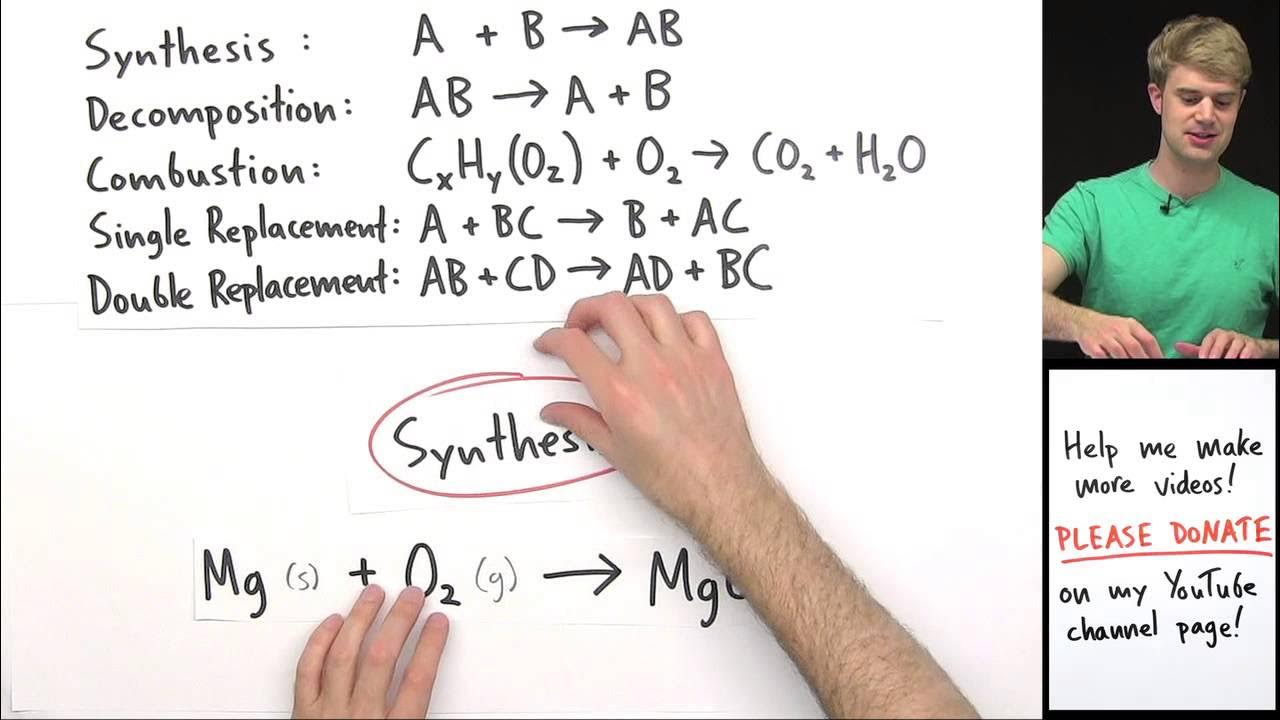BTEC Applied Science: Unit 1 Chemistry Calculating Masses in Reactions
TLDRThe video script discusses two chemical reactions: the neutralization of hydrochloric acid with sodium hydroxide to form sodium chloride and water, and the thermal decomposition of magnesium nitrate to produce magnesium oxide, nitrogen dioxide, and oxygen. It explains the process of balancing chemical equations and calculating the molar masses and the amounts of reactants and products involved. The script provides a step-by-step guide on how to determine the mass of sodium hydroxide needed to react with 100 grams of hydrochloric acid and how to calculate the mass of products formed from the decomposition of 3.5 grams of magnesium nitrate.
Takeaways
- 🧪 The script discusses the process of calculating masses in chemical reactions, specifically focusing on the reaction between hydrochloric acid (HCl) and sodium hydroxide (NaOH) to produce sodium chloride (NaCl) and water (H2O).
- ⚖️ The balanced chemical equation is confirmed, which is essential for performing stoichiometric calculations.
- 📈 Molar masses of the compounds involved are calculated: HCl (36.5 g/mol), NaOH (40 g/mol), NaCl (58.5 g/mol), and H2O (18 g/mol).
- 🔢 The number of moles of HCl in 100 grams is determined by dividing the mass by the molar mass, which is 100 grams / 36.5 g/mol.
- 💧 From the stoichiometry, it is understood that 1 mole of HCl reacts with 1 mole of NaOH, thus the moles of NaOH required for 100 grams of HCl is equal to the moles of HCl.
- 🧂 The mass of NaCl produced is calculated by multiplying the moles of HCl by the stoichiometric ratio and the molar mass of NaCl.
- 🔥 Another reaction discussed is the thermal decomposition of magnesium nitrate to produce magnesium oxide, nitrogen dioxide, and oxygen.
- 🌡️ The script provides an example calculation for the decomposition of 3.5 grams of magnesium nitrate, including the determination of moles and masses of the products.
- 📊 The balanced equation for the decomposition of magnesium nitrate is verified, and the stoichiometric ratios are used to calculate the moles and masses of the products.
- 📝 The process of calculating moles and masses in chemical reactions is emphasized, highlighting the importance of understanding molar mass and stoichiometry.
- 🎓 The script serves as an educational resource for learning how to perform calculations related to chemical reactions, providing a step-by-step approach to solving such problems.
Q & A
What is the balanced chemical equation for the reaction between hydrochloric acid and sodium hydroxide?
-The balanced chemical equation for the reaction between hydrochloric acid (HCl) and sodium hydroxide (NaOH) is: HCl + NaOH → NaCl + H2O. This reaction is a neutralization reaction that produces sodium chloride (NaCl), commonly known as salt, and water (H2O).
How do you determine the molar mass of a compound?
-The molar mass of a compound is determined by summing the atomic masses of all the elements in the compound. It is typically expressed in grams per mole (g/mol) and can be calculated by adding the atomic masses of each element as given in the periodic table.
What is the molar mass of hydrochloric acid (HCl)?
-The molar mass of hydrochloric acid (HCl) is approximately 36.5 g/mol, which is the sum of the atomic mass of hydrogen (1.0 g/mol) and chlorine (35.5 g/mol).
How many moles of sodium hydroxide (NaOH) will react with 100 grams of hydrochloric acid (HCl)?
-To determine how many moles of sodium hydroxide (NaOH) will react with 100 grams of hydrochloric acid (HCl), first calculate the moles of HCl. Since the molar mass of HCl is 36.5 g/mol, divide 100 grams by 36.5 g/mol to get approximately 2.74 moles of HCl. Because the stoichiometry of the reaction is 1:1, you will also need 2.74 moles of NaOH to completely react with 100 grams of HCl.
What is the mass of sodium chloride (NaCl) produced from the reaction of 100 grams of hydrochloric acid (HCl) with sodium hydroxide (NaOH)?
-Since the stoichiometry of the reaction is 1:1, the moles of sodium chloride (NaCl) produced will be equal to the moles of hydrochloric acid (HCl) used, which is 2.74 moles. Knowing that the molar mass of NaCl is approximately 58.5 g/mol, multiply the moles of NaCl by its molar mass to find the mass: 2.74 moles * 58.5 g/mol ≈ 160.29 grams of NaCl will be produced.
What happens when magnesium nitrate is heated?
-When magnesium nitrate is heated, it undergoes a decomposition reaction, breaking down into magnesium oxide (MgO), nitrogen dioxide (NO2), and oxygen (O2). This process is a thermal decomposition reaction.
What is the balanced chemical equation for the decomposition of magnesium nitrate?
-The balanced chemical equation for the decomposition of magnesium nitrate (Mg(NO3)2) upon heating is: Mg(NO3)2 → MgO + 2NO2 + O2. This equation shows that one mole of magnesium nitrate decomposes to produce one mole of magnesium oxide, two moles of nitrogen dioxide, and one mole of oxygen.
How many moles of product are obtained from each mole of magnesium nitrate that decomposes?
-According to the balanced equation, one mole of magnesium nitrate decomposes to yield one mole of magnesium oxide (MgO), two moles of nitrogen dioxide (NO2), and one mole of oxygen (O2).
What is the molar mass of magnesium nitrate (Mg(NO3)2)?
-The molar mass of magnesium nitrate (Mg(NO3)2) is calculated by adding the molar masses of magnesium (Mg, 24.3 g/mol) and two nitrate ions (2 * (N, 14.0 g/mol + 3 * O, 3 * 16.0 g/mol)). The total molar mass is approximately 148.3 g/mol.
How many grams of each product are produced from the decomposition of 3.5 grams of magnesium nitrate?
-First, calculate the moles of magnesium nitrate used: 3.5 grams / 148.3 g/mol ≈ 0.0236 moles. According to the stoichiometry of the reaction, this will produce 0.0236 moles of MgO, 0.0472 moles of NO2 (twice as many), and 0.0118 moles of O2 (half as many). To find the mass of each product, multiply the moles by their respective molar masses: MgO (40.3 g/mol), NO2 (46.0 g/mol), and O2 (32.0 g/mol).
What is the significance of the stoichiometry in a chemical reaction?
-Stoichiometry in a chemical reaction is significant because it defines the quantitative relationships between reactants and products. It tells us the ratio of moles of each reactant that will react and the amount of each product that will be formed. This is crucial for understanding the yield of a reaction and for ensuring that reactions are carried out with the correct amounts of substances to maximize efficiency and minimize waste.
How can you check if a chemical equation is balanced?
-To check if a chemical equation is balanced, ensure that the number of atoms of each element on the reactant side is equal to the number of atoms of the same element on the product side. The law of conservation of mass states that atoms are neither created nor destroyed in a chemical reaction, so the total mass of atoms before and after the reaction must be equal.
Outlines
🧪 Chemistry Calculations: Reactions and Molar Masses
This paragraph discusses the process of calculating masses in chemical reactions, using the example of a neutralization reaction between hydrochloric acid and sodium hydroxide to form sodium chloride and water. The explanation covers the importance of having a balanced chemical equation and the method to determine the molar masses of the compounds involved. It then proceeds to calculate the number of moles in 100 grams of hydrochloric acid and uses stoichiometry to find the required mass of sodium hydroxide to completely react with it and the mass of sodium chloride produced. The paragraph also introduces another example involving the decomposition of magnesium nitrate upon heating into magnesium oxide, nitrogen dioxide, and oxygen, emphasizing the need to balance the equation and calculate the molar masses to find the amounts of products formed.
🌡️ Thermal Decomposition of Magnesium Nitrate: Moles and Masses
This paragraph delves into the calculation of products formed from the thermal decomposition of magnesium nitrate. It begins by confirming that the chemical equation is balanced and then moves on to calculate the moles of magnesium nitrate based on the given mass of 3.5 grams. Using the stoichiometry from the balanced equation, the paragraph determines the moles of magnesium oxide, nitrogen dioxide, and oxygen produced. The next step involves calculating the mass of each product using the molar masses of the substances. The summary also prompts the viewer to verify the balance of the equation and to calculate the molar masses of the reactants and products for a comprehensive understanding of the reaction.
Mindmap
Keywords
💡Chemical Reaction
💡Moles
💡Molar Mass
💡Stoichiometry
💡Neutralization
💡Sodium Hydroxide
💡Hydrochloric Acid
💡Sodium Chloride
💡Water
💡Magnesium Nitrate
💡Decomposition Reaction
Highlights
Chemical reaction between hydrochloric acid and sodium hydroxide results in sodium chloride and water.
The balanced chemical equation for the reaction is HCl + NaOH → NaCl + H2O.
One mole of hydrochloric acid reacts with one mole of sodium hydroxide to produce one mole of sodium chloride and one mole of water.
To determine the mass of sodium hydroxide reacting with 100 grams of HCl, first calculate the molar mass of each compound.
The molar mass of HCl is 36.5 g/mol, NaOH is 40 g/mol, NaCl is 58.5 g/mol, and H2O is 18 g/mol.
Calculate the moles of HCl in 100 grams by dividing the mass by the molar mass (100 g / 36.5 g/mol).
The moles of NaOH required to react with 100 grams of HCl will be the same as the moles of HCl calculated.
Determine the mass of NaCl produced by multiplying the moles of NaCl by its molar mass.
In the second example, magnesium nitrate breaks down into magnesium oxide, nitrogen dioxide, and oxygen when heated.
The balanced equation for the thermal decomposition of magnesium nitrate is Mg(NO3)2 → MgO + 2NO2 + O2.
From one mole of magnesium nitrate, you get one mole of magnesium oxide, two moles of nitrogen dioxide, and half a mole of oxygen.
To find the moles of products from 3.5 grams of magnesium nitrate, divide the mass by the molar mass of Mg(NO3)2 (3.5 g / 148.3 g/mol).
Calculate the moles of each product using the molar mass and the given mass of the reactant.
Determine the mass of each product by multiplying the moles by the respective molar masses.
The process of calculating moles and masses in chemical reactions is essential for understanding stoichiometry.
These calculations are crucial for predicting the outcomes of chemical reactions in a laboratory setting.
Stoichiometry allows chemists to balance chemical equations and predict the quantities of reactants and products.
Understanding the molar mass of compounds is fundamental to performing stoichiometric calculations.
These methods can be applied to a wide range of chemical reactions, not limited to the examples provided.
The ability to calculate and predict chemical outcomes is vital for various industrial and environmental applications.
This knowledge forms the basis for many chemical engineering processes and helps in optimizing reactions for desired outcomes.
The concepts discussed are crucial for students studying chemistry and related scientific fields.
These calculations demonstrate the practical application of theoretical chemical knowledge.
The process of breaking down complex chemical reactions into manageable calculations is key to understanding chemistry at a deeper level.
Transcripts
Browse More Related Video

Classifying Types of Chemical Reactions Practice Problems

Introduction to Double Replacement Reactions

Solution Stoichiometry - Finding Molarity, Mass & Volume

How To Write Net Ionic Equations In Chemistry - A Simple Method!

Predicting Products | Decomposition Reactions

Another Stoichiometry Example in a Solution
5.0 / 5 (0 votes)
Thanks for rating: